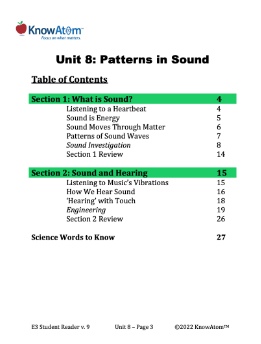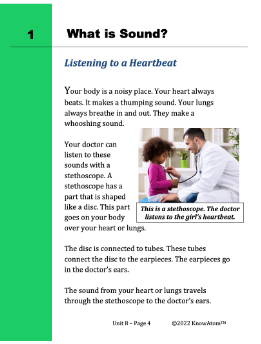In this lesson, students apply what they know about sound energy to design a toy that can be used to “trick” how their brain determines where a sound originates.
In this unit, students analyze the science phenomenon of how sound is a form of energy that travels through vibrating molecules. They test whether sound travels through both liquid and solid mediums and observe how sound makes sand particles vibrate. In this lesson, students apply their scientific knowledge of sound to an engineering challenge. This page is a high-level extract of this lesson.
The science background section gives teachers more in-depth information about the phenomena students explore in this unit - in this case, sound.
Powerful sound waves damage hair cells, causing eventual hearing loss in old age, as hair cells do not grow back.
For people like Evelyn, who have hearing loss at a young age, there is something not functioning in their ears. Millions of people around the world have some hearing loss or cannot hear sound at all.
There are many reasons why a person may have hearing loss. Some people are born without the ability to hear. Other people lose the ability to hear because of illness, old age, or chemicals. Listening to loud noises for a long time can also cause hearing loss over time. No matter how people lose their hearing, hearing loss means their ears are not translating sound energy into sounds.
But they can still feel the vibrations using other senses. They can use their sense of touch to feel the vibrations. Touch is the most effective sense in the human body. The skin tells us whether we are in contact with an object, if that object is doing us harm, and whether that object is hot or cold. Nerve endings communicate this information and are found all over the body, especially in the fingertips.
This is how Evelyn Glennie became a percussionist, working with her teacher to feel the vibrations of different sounds. “I would put my hands on the wall of the music room, and together we would "listen" to the sounds of the instruments, and really try to connect with those sounds far, far more broadly than simply depending on the ear,” Glennie said in a 2003 TED talk.
Glennie learned to identify sounds with different pitches according to where she felt the vibrations on her body. She has said that she feels low sounds in her legs and feet, and high sounds on her face, neck, and chest.
In this lesson, students apply what they know about sound energy to design a toy that can be used to “trick” how their brain determines where a sound originates.

Prepared hands-on materials, full year grade-specific curriculum, and personalized live professional development designed to support mastery of current state science standards.
Misconception: Sound can travel through empty space.
Fact: Sound moves in waves of vibrating molecules, so it cannot travel in empty space, where there are no molecules to pass along the energy.
Misconception: Sounds cannot travel through liquids or solids.
Fact: Sounds can travel through any medium, which can be solid, liquid, or gas.
Ear : the part of the body that senses sound
Hearing : the brain’s interpretation of information carried by sound waves
Medium : the matter that waves travel through; can be a solid, liquid, or gas
Sound : energy that is carried in waves of vibrating molecules
Sound Wave : a pattern of vibrating molecules caused by the movement of sound through a medium
Vibrate : to move back and forth quickly
Volume : how loud or soft a sound seems; a loud sound carries more energy than a soft sound
Listening to Music’s Vibrations
Evelyn Glennie is a percussionist. This means she plays musical instruments that are shaken or hit. Drums are percussion instruments.
Evelyn owns more than 1,300 musical instruments. One of these instruments is a set of cut and tuned car exhaust pipes. She has won several awards for her music.
Evelyn is also famous because she is profoundly deaf. This means that she cannot hear speech, but she can hear some sound. Hearing is the brain’s interpretation of information carried by sound waves. Evelyn lost her hearing when she was 12 years old. She didn’t let that stop her. She taught herself to play using the feelings of the vibrations made by different sounds.
How We Hear Sound
Evelyn has said that hearing is a special kind of touch. This is because of the relationship between sound and vibrations.
Remember that as forces transfer energy through a system, they disturb molecules at rest. This causes the molecules to vibrate. As energy is carried in waves of vibrating molecules, it produces sound. Sound travels outward from the source.
If a person who is not deaf is within the range of these vibrating molecules, their ears pick up the vibrations and hear them as sound. Ears are the parts of the body that sense sound. Humans have two ears. We use both ears to help our brain figure out where sounds are coming from. With two ears, we can hear sounds from opposite directions.
If you cup your hand around your ear, you can make some sounds appear louder. This is because you cause more sound waves to move through a smaller area.
Human ears have three parts that work together. Each ear has an outer ear, a middle ear, and an inner ear. The outer ear is the part we can all see. Its job is to collect sounds. When vibrating molecules reach the outer ear, they travel down a tunnel called the ear canal. The ear canal directs the sound waves so they are easier to hear. When the sound waves reach the eardrum, they make the eardrum vibrate.



In this lesson, students use information from a scenario to help them define the main problem facing a toy factory, which needs engineers to design a new toy for children that will trick their brain’s sense of sound. They work in teams to come up with possible solutions to solve the problem. Once they have built a prototype, they carry out a procedure for testing it to see how well it solves the problem. Students use the data and observations from their prototypes to describe how well their prototype solved the problem given the criteria and constraints, how their modifications positively or negatively affected their prototype’s ability to trick the brain, and to decide if they would refine or replicate any of their designs based on the data. Students use the data from their testing to communicate about how well their prototype solved the problem presented in the scenario.
KnowAtom incorporates formative and summative assessments designed to make students thinking visible for deeper student-centered learning.

Standards citation: NGSS Lead States. 2013. Next Generation Science Standards: For States, By States. Washington, DC: The National Academies Press. Neither WestEd nor the lead states and partners that developed the Next Generation Science Standards were involved in the production of this product, and do not endorse it.
